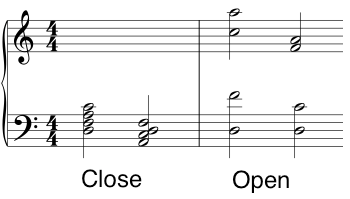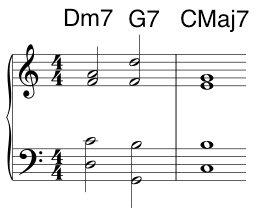Two Handed Chord Voicings
The piano is in the rhythm section of the band. This means you are in charge of playing chords (‘Comp) while someone else solos. While left hand only chord voicings are nice and simple, they don’t sound as rich or balanced as two handed chord voicings. By using both hands to play a chord, we can play over a number of octave and registers and create a fuller sound.
Further, occasionally you will play a solo piece or will have to improvise yourself in a group setting. In these instances you will have to both play the chords and the melody/improvise. When playing left hand only chord voicings, it’s easy enough to just play the melody with your right hand. But when you’re playing two handed chord voicings, you have to play voicings where the melody note is on top. For this reason it is important that you know a large number of different voicings with different melody notes on top. This way, if you come across a m7 chord with a 7th in the melody, you’ll have a m7 chord voicing with a 7th on top ready to go. Or if you come across a V7 chord with a 9th in the melody, you’ll have a V7 chord voicing with a 9th on top at your disposal.
A good way to being learning such voicings is by practicing open chord voicings (or spread voicings).
Close vs Open Chord Voicings
To play in ‘close harmony’ means to play all the notes of the chord within the range of a single octave. While to play in ‘open harmony’ (AKA open position, AKA open chord voicings, AKA spread voicings) means to play all the same notes but over a span larger than an octave. This spreads your chord out over a wider range and in this way creates a richer, more balanced and more ‘open’ sound.
If we first stick to 7th chords, then we have 4 notes that we need to play in each chord. So it’s easy to split the chord in half and play two notes per hand.
Good open chord voicings can be voiced as follows:
| Chord | Left Hand | Right Hand |
|---|---|---|
| 1 | Root & 10th | 5th & 7th |
| 2 | Root & 7th | 3rd & 5th |

So you can play a II-V-I in C using Open Chord Voicings as follows:
| Chord | Left Hand | Right Hand |
|---|---|---|
| Dm7 | D-C | F-A |
| G7 | G-B (10th) | F-D |
| CMaj7 | C-B | E-G |

Spread Voicing Rules
- Generally, try to avoid ‘doubling’ a note (i.e. playing it twice) unless it is the top note;
- Put the melody note on top of the chord;
- If the melody is the root note, you’re allowed to double the root note
- Avoid playing an interval of a fifth in your left hand
- Use wider intervals in the bass to avoid muddiness